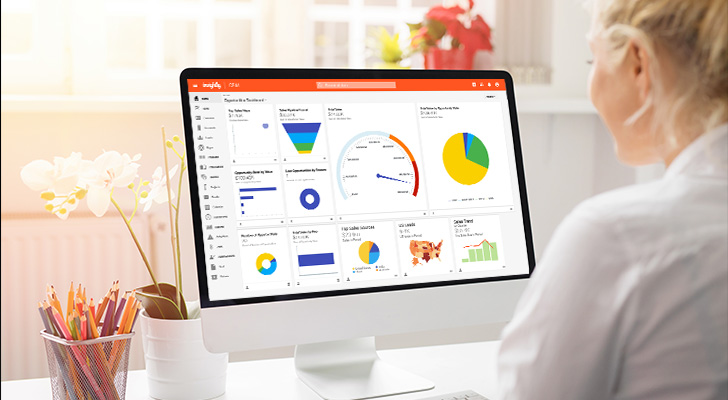Why it’s important to have strong CRM adoption
If you are struggling with CRM adoption in your organization, you’re not alone.
You’re likely looking for a way to fix it. Switching CRMs might sound like a quick fix. Companies switch CRMs for a variety of reasons, not the least of which includes low user adoption. But even switching CRMs is no guarantee of success.
In fact, failing to implement a rock-solid adoption plan is a recipe for repeat failure. This puts you in an endless cycle of throwing good money after bad and using up scarce resources which can impede your growth.
Let’s explore CRM adoption issues, and review a few CRM adoption best practices to address CRM adoption challenges, to maximize use of your CRM and improve CRM adoption.
Why is your current CRM failing?

CRM adoption statistics aren’t great. In fact, the average CRM adoption rate may surprise you. Between 18 and 69 percent of CRM implementations fail in some way. This means CRM adoption rates are low. Pointing fingers at your current CRM seems like the easy thing to do. “It doesn’t have the features that we need to be successful,” says your top sales rep. “It’s confusing, and data is everywhere,” says your CRM administrator. “Integrating to our marketing automation system is painful and time-consuming,” says your marketing manager.
While all of these statements may be true, a more objective look at the situation could also uncover deeper problems than substandard features and data silos.
Here are a few reasons why companies fail with their CRMs, and, as a result, accelerate the downward spiral of their already low utilization rates.
Lack of upfront training and support
Some vendors try to make the CRM buying process feel like a trip to the supermarket. Just browse for what you need, load up your cart, pay your bill, and be on your merry way.
In reality, choosing a CRM has very little in common with grocery shopping. Selecting and implementing the perfect CRM for your business, is a multifaceted process that requires adequate research, planning, and input from stakeholders across the organization.
A reliable CRM vendor walks with you (even after you’ve paid the bill) to ensure that you have a comprehensive onboarding experience, robust documentation, helpful online user community, and value-added professional services.
Questions to consider: How thorough was the training, onboarding, and support that you received from your current vendor? Did they make mistakes that contributed to your current situation?
Misalignment in system ownership
For many companies, delegating CRM administration to the IT department makes total sense. After all, your CRM houses the most confidential customer data, documents, and strategic insights. Maintaining tight control over user access and data integrity certainly falls within the IT department’s purview.
On the other hand, sales is the primary CRM user and is closest to the customer. Perhaps your sales director would like to customize the system without bothering IT, but, unfortunately, it’s complicated. Changes to one area might break something else. As a result, the sales team just tries its best to make things work as is.
Questions to consider: Who “owns” the success of your CRM? What does success actually look like? Do administrative bottlenecks reduce your chances of achieving success?
CRM stagnation despite rapid business change
Fundamentally, a CRM should make it easier for your teams to understand customers, engage them, and identify profitable business opportunities. That’s tough to guarantee when your business model is evolving faster than ever—especially when your CRM can’t keep pace.
Granted, some CRMs are easier to customize than others. Customization for customization’s sake, however, can lead to unnecessary data fields that overwhelm users and create an unpleasant experience, which inhibits customer relationship management.
Questions to consider: What assumptions were made during adoption that are no longer valid? Was your current CRM customized too heavily (or not enough) based on one or more bad assumptions? Does your CRM vendor check in with you to make sure your setup is aligned with your business goals?
How to Increase CRM Adoption Rates

What is CRM adoption?
So, how can you avoid these types of issues and improve adoption or ensure your next CRM project is a success? CRM adoption rates are universal, meaning CRM adoption by industry doesn’t show much deviation. CRM adoption in healthcare is about the same as CRM adoption in manufacturing. All industries can suffer from poor CRM user adoption statistics and can get better at driving CRM adoption.
As a simple illustration, let’s compare your CRM implementation to that of planting a garden. Before you ever plant the first seed, there’s a considerable amount of tilling, hoeing, fertilizing, and watering that must be done. All of this prepares the ground to receive the vegetable seed, and, in turn, increases the chances of survival.
Now, let’s apply this analogy to your company. How can you ensure that your new CRM (the “seed”) bears good produce? A CRM adoption plan is key; it drives your CRM user adoption strategy and mitigates CRM adoption issues. Here are a few ideas to consider:
1. Involve users from the start
Adoption and implementation of a CRM starts on day 1. Don’t allow your IT Director or Chief Revenue Officer to operate in a vacuum and fail to seek input from other stakeholders. Onboarding a new CRM impacts multiple departments and teams; therefore, each team should have at least a seat at the table. A cross-functional team is essential. Conversely, don’t try to do everything by consensus. The team is there to foster greater alignment, share ideas, and rally around a common cause. Ultimately, one specific team member should own the success or failure of the project. This person should have more decision-making power and final say on important matters.
2. Personalize your CRM experience
You’ll need to set a clear definition of success to and continue driving CRM adoption. What does the team’s shared vision of success look like? What is a reasonable CRM user adoption rate, and what reports are necessary for measuring progress toward that goal? Ask yourself these CRM adoption questions. Start with “What is CRM adoption?” Define key dates, timelines, CRM adoption KPIs, and accountability mechanisms. Ideally, your new CRM will provide native tools to help track your CRM adoption statistics, CRM adoption rates, and the success or failure of your CRM adoption metrics.
3. Train your employees
When the new CRM is launched, training your employees is vital to CRM adoption. Think ahead to what are some CRM system adoption challenges and have a plan to mitigate them. The training timeline is also vital to CRM adoption – too soon and they’ll forget what to do at launch time. Too late, and they’ll have frustration in the early days which will sour the experience for everyone. Training should include change and transition management by preparing the team for the process, when the old system(s) will cease to be in use and when the new system will be turned on. Managing those in-between times can be vital to CRM adoption.
4. Provide support
Determine what types of support your team will handle internally and what types of issues for which you’ll need help from the vendor. Document these divisions and create expectations for the turnaround times for each to help with CRM adoption.
Adding new users. Assigning roles and permissions. Customizing contact records. Building automated workflows and integrations. Who in your organization should perform these and other CRM tasks? What is a reasonable turnaround for each task, and how will you measure deviations from the norm? Set clear expectations now to avoid unnecessary friction and misalignment later. If it’s a simple password reset that will be handled by IT, you know it can take minutes. If a team is requesting a custom field, you may need more time or help from customer success.
It’s helpful to leverage vendor-provided resources to the fullest and not overlook the services and resources that they provide. Be sure to utilize every coaching session, training webinar, how-to video, and support article. Are you also entitled to ongoing support or a success plan as part of your contract? If so, implement safeguards so that users take advantage of such services in the future.
Some vendors offer add-on, premium onboarding, training, and support services. Although the cost is certainly incremental, the long-term savings could far outweigh the upfront investment—especially if your staff is already overworked. For example, Insightly offers several training and support plans that can get you up and running faster and with less effort from in-house staff.
5. Get employee feedback

Make plans ahead of your launch for periodic check-ins with end users. This can be formalized in a series of surveys that happen, for example, one week, one month, and three months after implementation. Or, it can be informal town halls or even a Slack/Teams channel. If end-users feel they are seen, heard and understood, they are more likely to hop on board with CRM adoption.
6. Make your CRM the only solution
Everyone on your team must be all-in on the CRM. Don’t confuse people with multiple, overlapping systems since this will threaten the success of your implementation. Your CRM is the single source of truth for your business and the heart of your business. Its use is not optional. One way to keep end users in line with CRM adoption is to have other tools in your organization integrate with it, like Slack, QuickBooks, and more. Integrations are easy with a no-code/low-code integration tool like AppConnect from Insightly.
7. Track early CRM improvements
Everyone loves a quick win! If you can start showing improvements in CRM adoption out of the gate, you’ll be in good shape. Set your CRM adoption KPIs early and then check against them. Consider a CRM adoption dashboard for easy reporting. Can you compare usage of your new CRM to your previous CRM or to your old system of spreadsheets? Can you see larger deal sizes emerging within a few months? These are all signs that your new system is affecting change.
Improve your CRM Adoption Rate with Insightly
By developing a healthy mix of people, technology, and vendor-provided solutions, you can give your CRM every chance to thrive. But remember, your company’s needs will be constantly changing, which means your CRM must constantly change, too. Users are more likely to adopt a system that is modern, flexible and easy to use. If you’re looking for a new CRM, check out Insightly. You can view an on-demand demo at your convenience, request a personalized demo, or start a free trial right away.
Additional helpful links
More information on this topic is available on the following pages:



